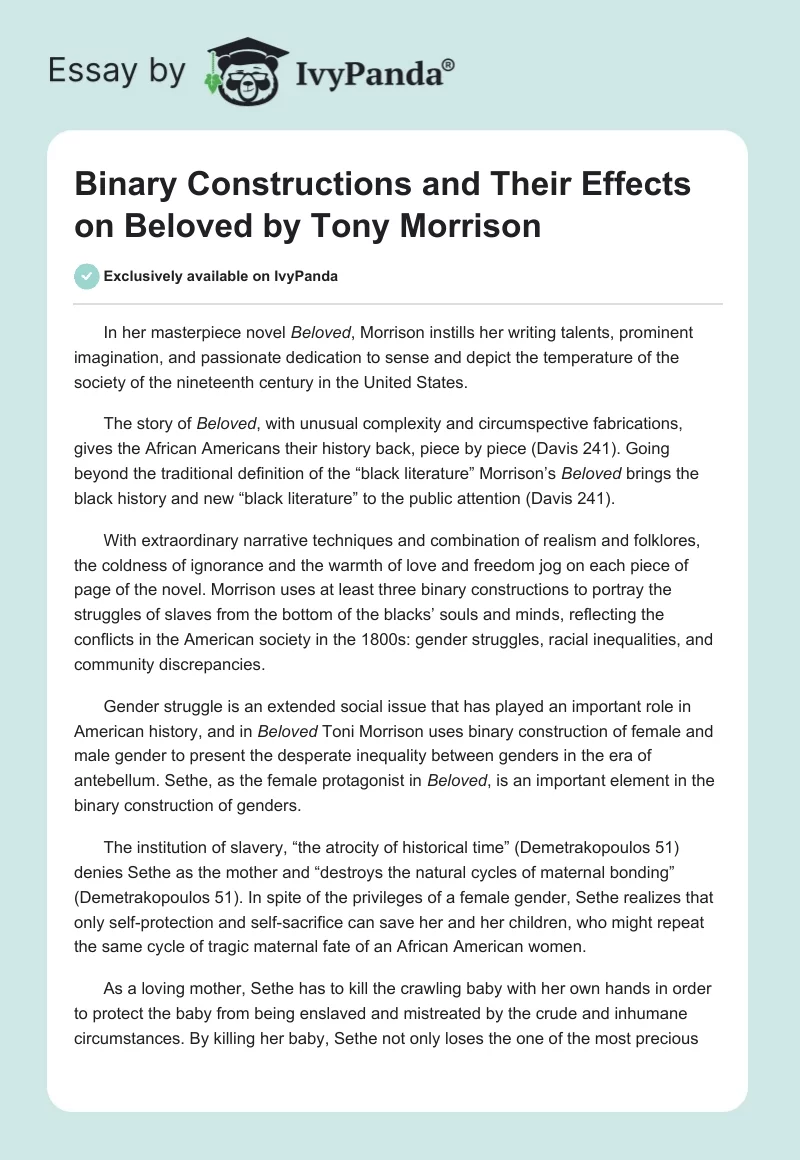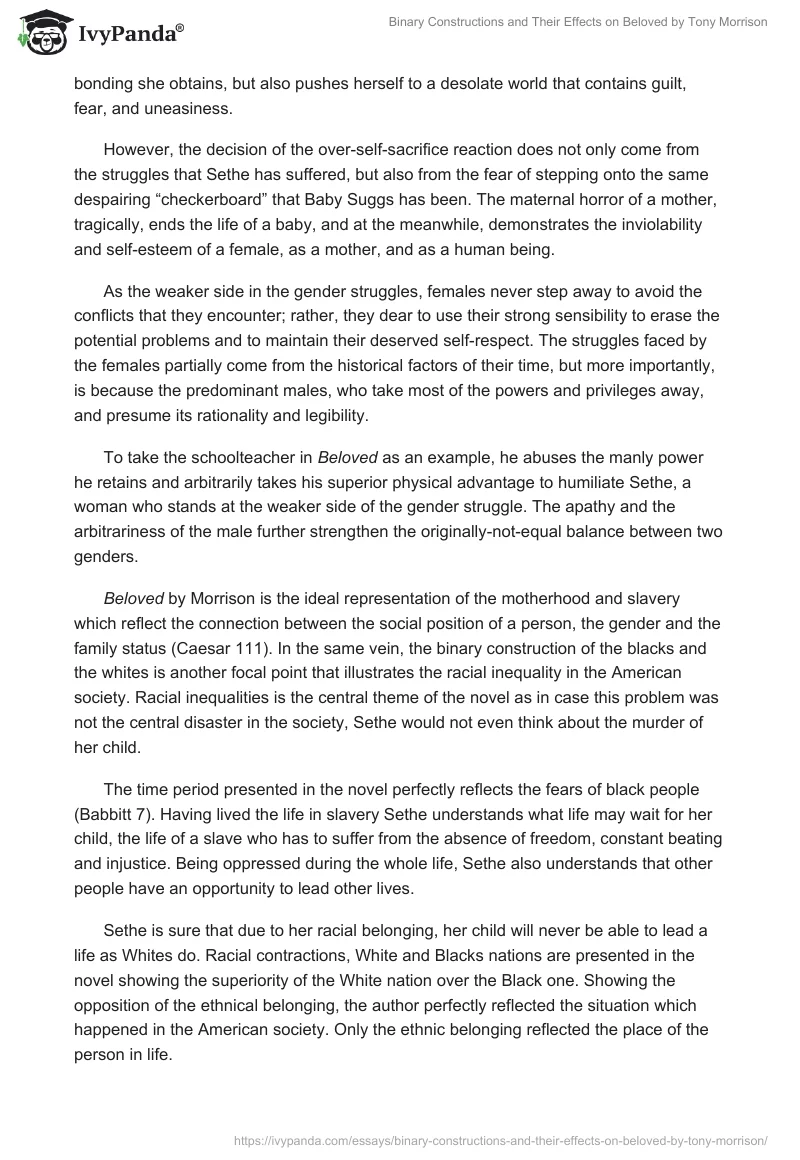In her masterpiece novel Beloved, Morrison instills her writing talents, prominent imagination, and passionate dedication to sense and depict the temperature of the society of the nineteenth century in the United States.
The story of Beloved, with unusual complexity and circumspective fabrications, gives the African Americans their history back, piece by piece (Davis 241). Going beyond the traditional definition of the “black literature” Morrison’s Beloved brings the black history and new “black literature” to the public attention (Davis 241).
With extraordinary narrative techniques and combination of realism and folklores, the coldness of ignorance and the warmth of love and freedom jog on each piece of page of the novel. Morrison uses at least three binary constructions to portray the struggles of slaves from the bottom of the blacks’ souls and minds, reflecting the conflicts in the American society in the 1800s: gender struggles, racial inequalities, and community discrepancies.
Gender struggle is an extended social issue that has played an important role in American history, and in Beloved Toni Morrison uses binary construction of female and male gender to present the desperate inequality between genders in the era of antebellum. Sethe, as the female protagonist in Beloved, is an important element in the binary construction of genders.
The institution of slavery, “the atrocity of historical time” (Demetrakopoulos 51) denies Sethe as the mother and “destroys the natural cycles of maternal bonding” (Demetrakopoulos 51). In spite of the privileges of a female gender, Sethe realizes that only self-protection and self-sacrifice can save her and her children, who might repeat the same cycle of tragic maternal fate of an African American women.
As a loving mother, Sethe has to kill the crawling baby with her own hands in order to protect the baby from being enslaved and mistreated by the crude and inhumane circumstances. By killing her baby, Sethe not only loses the one of the most precious bonding she obtains, but also pushes herself to a desolate world that contains guilt, fear, and uneasiness.
However, the decision of the over-self-sacrifice reaction does not only come from the struggles that Sethe has suffered, but also from the fear of stepping onto the same despairing “checkerboard” that Baby Suggs has been. The maternal horror of a mother, tragically, ends the life of a baby, and at the meanwhile, demonstrates the inviolability and self-esteem of a female, as a mother, and as a human being.
As the weaker side in the gender struggles, females never step away to avoid the conflicts that they encounter; rather, they dear to use their strong sensibility to erase the potential problems and to maintain their deserved self-respect. The struggles faced by the females partially come from the historical factors of their time, but more importantly, is because the predominant males, who take most of the powers and privileges away, and presume its rationality and legibility.
To take the schoolteacher in Beloved as an example, he abuses the manly power he retains and arbitrarily takes his superior physical advantage to humiliate Sethe, a woman who stands at the weaker side of the gender struggle. The apathy and the arbitrariness of the male further strengthen the originally-not-equal balance between two genders.
Beloved by Morrison is the ideal representation of the motherhood and slavery which reflect the connection between the social position of a person, the gender and the family status (Caesar 111). In the same vein, the binary construction of the blacks and the whites is another focal point that illustrates the racial inequality in the American society. Racial inequalities is the central theme of the novel as in case this problem was not the central disaster in the society, Sethe would not even think about the murder of her child.
The time period presented in the novel perfectly reflects the fears of black people (Babbitt 7). Having lived the life in slavery Sethe understands what life may wait for her child, the life of a slave who has to suffer from the absence of freedom, constant beating and injustice. Being oppressed during the whole life, Sethe also understands that other people have an opportunity to lead other lives.
Sethe is sure that due to her racial belonging, her child will never be able to lead a life as Whites do. Racial contractions, White and Blacks nations are presented in the novel showing the superiority of the White nation over the Black one. Showing the opposition of the ethnical belonging, the author perfectly reflected the situation which happened in the American society. Only the ethnic belonging reflected the place of the person in life.
Conducting an analysis of the novel, Eckstein refers to the peculiarities of the African community stressing the idea that African community is much younger than al the prejudices and discrimination. Eckstein is sure that the author of the novel tries to reflect this idea in metaphorical music expression, “in the beginning there were no words. In the beginning there was the sound, and they all knew what that sound sounded like…” (in Eckstein 271).
Jesser and Reed are sure the novel is the good example of the black community and the domination of the female authority there. Reed states that by means of utterance like “women’s preaching narrative, cries and moans, sound becomes the vehicle for communal restoration and the means by which the women in the novel demonstrate spiritual authority” (55).
At the same time, shoving the time and space changes the author tries to remind people about the community they lived in and the peculiarities of this community. The researchers is sure that the narration processes “are linked to spatial formations and communal configurations” that helps the reader to feel the mood of the whole African community, but not the situation in one simple family.
In conclusion, it should be stated that Beloved by Toni Morrison is a great work which “puts into words three orders of experience that Western cultural narratives usually leave out: childbirth and nursing from a mother’s perspective; the desire of a preverbal infant; and the suffering of those destroyed by slavery, including the Africans who died on the slave ships” (Wyatt 474).
These ideas which reflect the binary constructions and make those crucial for understanding the novel. Toni Morrison wanted to show the life of people in contrast and have presented not only the social situation in the American society but has also provided the information about the gender opposition, ethnical differences and community peculiarities of the country which was burdened with racial discrimination and slavery.
Works Cited
Babbitt, Susan E. “Identity, Knowledge, and Toni Morrison’s “Beloved”: Questions about Understanding Racism.” Hypatia 9.3 (1994): 1-18. JSTOR. Web.
Caesar, Terry Paul. “Slavery and Motherhood in Toni Morrison’s “Beloved”.” Revista de Letras 34 (1994): 111-120. JSTOR. Web.
Davis, Kimberly Chabot. “Postmodern Blackness.” Twentieth Century Literature 44.2 (1998): 242-260. JSTOR. Web.
Demetrakopoulos, Stephanie. “Maternal Bonds as Devourers of Women’s Individuation in Toni Morrison’s Beloved.” African American Review 26.1 (1992): 51-59. JSTOR. Web.
Eckstein, Lars. “A Love Supreme: Jazzthetic Strategies in Toni Morrison’s “Beloved”.” African American Review 40.2 (2006): 271-283. JSTOR. Web.
Jesser, Nancy. “Violence, Home, and Community in Toni Morrison’s Beloved”. African American Review 33.2 (1999): 325-345. JSTOR. Web.
Reed, Roxanne R. “The Restorative Power of Sound: A Case for Communal Catharsis in Toni Morrison’s “Beloved”.” Journal of Feminist Studies in Religion 23.1 (2007): 55-71. JSTOR. Web.
Wyatt, Jean. “Giving Body to the Word: The Maternal Symbolic in Toni Morrison’s Beloved.” PMLA 108.3 (1993): 474-488. JSTOR. Web.


